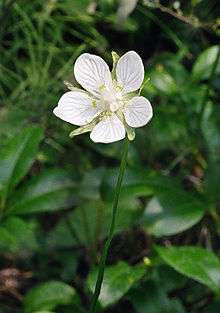Parnassia
- Grass of Parnassus is also the title of a book of poetry by Andrew Lang.
| Parnassia | |
|---|---|
 | |
| Parnassia palustris | |
| Scientific classification | |
| Kingdom: | Plantae |
| (unranked): | Angiosperms |
| (unranked): | Eudicots |
| (unranked): | Rosids |
| Order: | Celastrales |
| Family: | Celastraceae |
| Genus: | Parnassia L. |
| Species | |
The genus Parnassia, also known as Grass of Parnassus or bog-stars, are plants in the family Celastraceae.[3][4] The plants occur in arctic and alpine habitats, as well as in dune systems and fens, swamps, wet meadows, open seepage areas, moist woods, and across the Northern Hemisphere. It is actually not a grass, but an herbaceous dicot. The stalk of the plant can reach up to 8 inches (200 mm), the leaves up to 4 inches (100 mm) and the petals can be up to 1.4 inches (36 mm) wide. The flower has five white petals with light green venation. There are five three-pronged sterile stamens, each tipped with drop-like, false nectaries, which (along with the visual cue of veins) attract pollinating flies and bees.
Some species are often found in wet calcareous habitats with low fertility, low canopy cover, and high plant diversity.[5] Parnassia glauca is considered to be an indicator species of fens in New York State.[6] Such habitats are often becoming rare, and so species of Parnassia may have high conservation value. For example, Parnassia palustris is threatened and legally protected in Michigan[7] while Parnassia caroliniana is considered imperiled in North Carolina.[8]
Parnassus flowers are the symbol of the Clan MacLea, also known as the highland Livingstone clan, which is said to be the favorite flower of St. Moluag, the Irish missionary whose staff the clan chiefs hold.[9] Three Grass of Parnassus flowers appear on the Flag of Cumberland, a British county, as that flower grows on Cumberland's lofty fells.[10]
Species include:
- P. asarifolia
- P. cabulica
- P. caroliniana
- P. californica
- P. cirrata
- P. fimbriata
- P. foliosa
- P. glauca
- P. grandifolia
- P. kotzebuei
- P. palustris
- P. parviflora

References
| Wikimedia Commons has media related to Parnassia. |
- ↑ "Parnassiaceae". Flora of Pakistan.
- ↑ "Parnassia". Flora of China.
- ↑ "Parnassia L.". Germplasm Resources Information Network (GRIN). United States Department of Agriculture, Agricultural Research Service, Beltsville Area. Retrieved 8 January 2015.
- ↑ "Parnassia". Integrated Taxonomic Information System.
- ↑ Moore, Dwayne R. J.; Keddy, Paul A. (1988). "The relationship between species richness and standing crop in wetlands: the importance of scale". Vegetatio. 79 (1-2): 99–106. doi:10.1007/BF00044853.
- ↑ Godwin, Kevin S.; Shallenberger, James P.; Leopold, Donald J.; Bedford, Barbara L. (December 2002). "Linking landscape properties to local hydrogeologic gradients and plant species occurrence in minerotrophic fens of New York State, USA: A Hydrogeologic Setting (HGS) framework". Wetlands. 22 (4): 722–737. doi:10.1672/0277-5212(2002)022[0722:LLPTLH]2.0.CO;2.
- ↑ Michigan Natural Features Inventory. "Parnassia palustris (Marsh grass-of-parnassus) - MNFI Rare Species Explorer". Mnfi.anr.msu.edu. Retrieved March 1, 2015.
- ↑ North Carolina Native Plant Society. "Plant Details - Parnassia caroliniana". NCwildflower.org. Retrieved March 1, 2015.
- ↑ Clan MacLea. "Warrant for Letters Patent". Clanmclea.co.uk. Retrieved March 1, 2015.
- ↑ Robert Young. "Civic Heraldry of England and Wales - Cumberland". Civicheraldry.co.uk. Retrieved March 1, 2015.